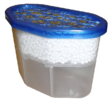- Joined
- 4 Sep 2022
- Messages
- 583
- Reaction score
- 3
- Country

But its OK for drying out a caravan if you leave the thing in there all the time?I use the cheap non-reusable silica things in the caravan over winter - keeps the thing reasonably dry so the cushions don't get stinky and start rotting.
For drying out a flooded house you're looking at days not hours.
How long dose it last before you have to recharge/ dry carterage?
I always wonder why they list generators with maximum run time on them of say 4-5 hoursCheap domestic gennies aren't rated for 100% duty- in that world you are looking at proper silent diesel sets.

